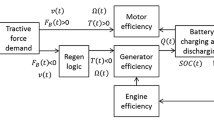Abstract
In this two-part paper, a topological analysis of powertrains for refuse-collecting vehicles (RCVs) based on the simulation of different architectures (internal combustion engine, hybrid electric, and hybrid hydraulic) on real routes is proposed. In this first part, a characterization of a standard route is performed, analyzing the average power consumption and the most frequent working points of an internal combustion engine (ICE) in real routes. This information is used to define alternative powertrain architectures. A hybrid hydraulic powertrain architecture is proposed and modelled. The proposed powertrain model is executed using two different control algorithms, with and without predictive strategies, with data obtained from real routes. A calculation engine (an algorithm which runs the vehicle models on real routes), is presented and used for simulations. This calculation engine has been specifically designed to analyze if the different alternative powertrain delivers the same performance of the original ICE. Finally, the overall performance of the different architectures and control strategies are summarized into a fuel and energy consumption table, which will be used in the second part of this paper to compare with the different architectures based on hybrid electric powertrain. The overall performance of the different architectures indicates that the use of a hybrid hydraulic powertrain with simple control laws can reduce the fuel consumption up to a 14 %.
Similar content being viewed by others
References
Baseley, S., Ehret, C., Greif, E. and Kliffken, M. (2007). Hydraulic hybrid systems for commercial vehicles. SAE Paper No. 2007-01-4150.
Bender, F. A., Kaszynski, M. and Sawodny, O. (2013). Drive cycle prediction and energy management optimization for hybrid hydraulic vehicles. IEEE Trans. Vehicular Technology 62, 8, 3581–3592.
Bosch Rexroth (2012). Hydrostatic Regenerative Braking System HRB. RE 94850/10.2012.
Cao, Z., Wu, S., Li, M. and Du, C. (2009). Series and parallel hybrid system performance comparison based on the city bus cycle. Power and Energy Engineering Conf., APPEEC 2009, Asia-Pacific, 1–5.
Chen, Y. L., Liu, S.-A., Jiang, J.-H., Shang, T., Zhang, Y.-K. and Wei, W. (2013). Dynamic analysis of energy storage unit of the hydraulic hybrid vehicle. Int. J. Automotive Technology 14, 1, 101–112.
Dembski, N., Rizzoni, G., Soliman, A., Fravert, J. and Kelly, K. (2005). Development of refuse vehicle driving and duty cycles. SAE Paper No. 2005-01-1165.
Esfahanian, M., Safaei, A., Nehzati, H., Esfahanian, V. and Tehrani, M. M. (2014). Matlab-based modeling, simulation and design package for eletric, hydraulic and flywheel hybrid powertrains of a city bus. Int. J. Automotive Technology 15, 6, 1001–1013.
Filipi, Z. and Kim, Y. J. (2010). Hydraulic hybrid propulsion for heavy vehicles: Combining the simulation and engine-in-the-loop techniques to maximize the fuel economy and emission benefits. Oil & Gas Science and Technology–Rev. IFP 65, 1, 155–178.
Hydac (2013). Sizing Accumulators. Innovative Fluid Power PN#02068195/04.13/ACU1102-1326.
Ivanco, A., Johri, R. and Filipi, Z. (2012). Assessing the regeneration potential for a refuse truck over a realworld duty cycle. SAE Int. J. Commer. Veh. 5, 1, 364–370.
Ivanic, Ž. (2007). Data collection and development of New York city refuse truck duty cycle. SAE Paper No. 2007-01-4118.
Kim, Y. and Filipi, Z. (2007). Simulation study of a series hydraulic hybrid propulsion system for a light truck. SAE Paper No. 2007-01-4151.
Matsuura, M., Korematsu, K. and Tanaka, J. (2004). Fuel consumption improvement of vehicles by idling stop. SAE Paper No. 2004-01-1896.
Parker Runwise (2013). Advanced Series Hybrid Drive. HY34-1000, 03.
Proclain Hydraulics (2012). Addidrive Assist. A31037L, 08.
Soriano, F., Alvarez-Florez, J. and Moreno-Eguilaz, M. (2014). Experimentally compared fuel consumption modelling of refuse collecting vehicles for energy optimization purposes. SAE Int. J. Commer. Veh. 7, 1, 324–336.
Soriano, F., Moreno Eguilaz, M. and Alvarez-Florez, J. (2015). Drive cycle identification and energy demand estimation for refuse-collecting vehicles. IEEE Trans. Vehicular Technology 64, 11, 4965–4973.
Surampudi, B., Nedungadi, A., Ostrowski, G., Montemayor, A. and Gruenewald, H. (2009). Design and control considerations for a series heavy duty hybrid hydraulic vehicle. SAE Paper No. 2009-01-2717.
Wadsley, L. (2011). Optimal system solutions enabled by digital pumps. Int. Exposition for Power Transmission, IFPE, Las Vegas.
Wohlgemuth, S., Wachtmeister, G. and Kloft, P. (2013). Development of a hydraulic hybrid system for urban traffic. SAE Paper No. 2013-01-1479.
Wu, B., Lin, C., Filipi, Z., Peng, H. and Assanis, D. (2004). Optimal power management for a hydraulic hybrid delivery truck. Vehicle System Dynamics 42, 1–2. 23-40.
Wu, B., Lin, C., Filipi, Z., Peng, H. and Assanis, D. (2002). Optimization of power management strategies for a hydraulic hybrid medium truck. Proc. Advanced Vehicle Control Conf.
Author information
Authors and Affiliations
Corresponding author
Rights and permissions
About this article
Cite this article
Soriano, F., Moreno-Eguilaz, M., Alvarez, J. et al. Topological analysis of powertrains for refuse-collecting vehicles based on real routes–Part I: Hybrid hydraulic powertrain. Int.J Automot. Technol. 17, 873–882 (2016). https://doi.org/10.1007/s12239-016-0085-y
Received:
Revised:
Accepted:
Published:
Issue Date:
DOI: https://doi.org/10.1007/s12239-016-0085-y




